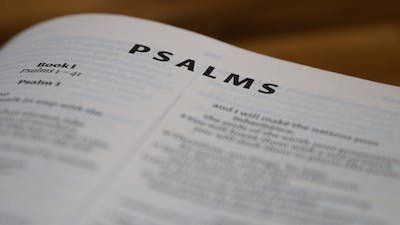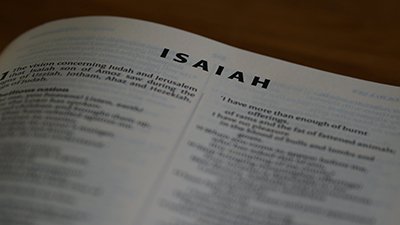Jesus: The Word, Life, and Light
An exegetical overview of John 1:1–5 relating to the coming of Jesus corresponding with the creation account in Genesis 1
In the beginning was the Word, and the Word was with God, and the Word was God. He was in the beginning with God. All things were made through him, and without him was not anything made that was made. In him was life, and the life was the light of men. The light shines in the darkness, and the darkness has not overcome it. (John 1:1–5)
The very first verse of the Bible tells us of the creation of the world: “In the beginning God created the heavens and the earth” (Genesis 1:1). Interestingly, the opening words of Genesis 1:1 are echoed in John 1:1: “In the beginning” (en archē).1 In a sense, Jesus’s coming into the world represents a “new creation.”2 The apostle John draws our attention to the coming of Jesus into the world as a “new creation” by referring to him as the “Word” (logos), “life” (zōē), and the “light” (phōs), which constitute creation terminology (Genesis 1:3–5; Psalm 33:6).3 It is helpful therefore to understand why these words are used to describe Jesus.
Jesus the Word
The pre-existence of the Word is an incredible claim, but it is one that Jesus made himself in his debate with the Pharisees (John 8:58) and when he prayed to the Father (John 17:5).
The very first verse of the Gospel of John informs us, “In the beginning was the Word, and the Word was with God, and the Word was God” (John 1:1). This one verse tells us three very important things about the Word (logos), who is identified as Jesus (John 1:17). First, the Word has eternally existed. The word “was” (ēn),4 which signifies existence, points to the Word already existing “in the beginning.” The pre-existence of the Word is an incredible claim, but it is one that Jesus made himself in his debate with the Pharisees (John 8:58) and when he prayed to the Father (John 17:5). Second, the Word has an eternal relationship with God (the Father, John 1:18). John describes the Word as being “with” (pros) God, which is a relational term showing that the person of the Word5 was with the person of God (the Father, cf. John 6:46; 1 John 1:2). Third, the Word as his nature is deity.6 The Word is not only distinct from God (the Word was with God), but the Word is God (theos).7 An equally decisive statement about the deity of Jesus is made in John 1:18: “No one has ever seen God; the only God, who is at the Father's side, he has made him known.” Once again John not only speaks of Jesus as pre-existing and being relationally with God (the Only God, who is at the Father’s side), but clearly states that he is God (the only God, monogenēs theos8). As the one who is at the Father’s side, the Word makes the Father known to us (cf. John 14:9). Since the prologue of John (1:1–18)9 clearly speaks of the deity of Jesus, it is not surprising that this finds an equally emphatic declaration throughout the gospel narrative (John 5:18, 8:58, 10:28–35) and at its end and climax when Thomas professed his faith in the resurrected Jesus: “My Lord and my God!” (John 20:28).
John 1:1 not only tells us who the Word was before creation, but John 1:3 tell us what he did in creation: “All things were made through him, and without him was not anything made that was made.” Greek Stoic philosophers used the term logos to refer to the rational principle by which everything exists. But this is not the primary point John is making here, as the Old Testament often speaks of God’s Word as his self-expression in creation, revelation, and salvation (Jeremiah 1:4; Isaiah 55:11; Psalm 107:20).10 By stating that “all things were made through him [logos],” John clearly is referring to the Jewish understanding of God’s Word as the means by which creation came into being: “By the word [logos, LXX] of the Lord the heavens were made” (Psalm 33:6). This is seen in Genesis 1 when God creates, not by means of natural processes, but by supernaturally speaking things into existence in the space of six days (Genesis 1:3, 6, 9, 11, 14, 20, 24, 26; cf. Exodus 20:11). John applies the title of the Word to the person of Jesus who is the creator of all things (cf. Colossians 1:16; Hebrews 1:2–3, 10–12). This is evident in his incarnation when Jesus performed other miracles—turning water into wine, feeding the five thousand (John 6:1–14), walking on water (6:16–21), and the miraculous catch of fish (John 21:4–8).
By stating that “all things were made through him [logos],” John clearly is referring to the Jewish understanding of God’s Word as the means by which creation came into being: “By the word [logos, LXX] of the Lord the heavens were made” (Psalm 33:6).
Most importantly, several verses later, John writes that the Word who was with God in the beginning “became flesh and dwelt among us” (John 1:14). Notice that John does not say that the Word stopped being God. The verb “became” (egeneto) does not mean there was a change in the deity of the Word; rather, he took on a human nature (cf. Philippians 2:5–8). In fact, John uses a very particular term here: skenoo “dwelt,” which means he “pitched his tent” or “tabernacled” among us. This is a direct parallel to the Old Testament record of when God “dwelt” in the tabernacle that Moses told the Israelites to construct (Exodus 25:8–9, 33:7). John is telling us that in the person of Jesus, God “dwelt” or “pitched his tent” among us. The incarnate Word has appeared to us as a person and communicates to us by his Word (the Scriptures), and by believing his words we have eternal life (John 5:24).
Jesus the Life and Light
The next thing John tells us is this: “In him was life and the life was the light of men. The light shines in the darkness, and the darkness has not overcome it” (John 1:4–5). Light and life are two essential features of creation in Genesis 1. But through his incarnation, Jesus has brought about more. John tells us that “life” was “in him.” As the Word, Jesus is not only the creator of physical life but also the source of eternal life. The Word was the one who breathed physical life into the first man, Adam (Genesis 2:7; cf. John 20:2211), but because of Adam’s disobedience, his descendants are born in sin, which issues a loss of spiritual life and causes mankind to walk in darkness (John 8:12; cf. 1 John 1:6; 2:11). Because of our sin and fallen nature, human effort is no help for providing eternal life, but Jesus’s own words are filled with the power of the Spirit and produce “life” in those who accept them by faith (John 6:63, 68). The “Word became flesh” in order that through his sacrificial death on the cross and resurrection from the dead, Jesus would bring about eternal life to all who trust in him (John 3:15–16, 11:25–26, 14:6). Those who trust in Jesus no longer come under God’s judgment but pass from death to life (John 3:36; 5:24; cf. Romans 8:1). In fact, the purpose of John’s Gospel is that those who read it “may believe that Jesus is the Christ, the Son of God, and that by believing you may have life in his name” (John 20:31).
In Genesis 1, God’s first recorded spoken, creative act was to speak forth “light” into existence, which separated the physical light from the darkness (Genesis 1:3–5). Jesus’s coming into the world, however, now separates between spiritual light and darkness (skotia).
Jesus not only brings “life” into a fallen world, but also “light.” In Genesis 1, God’s first recorded spoken, creative act was to speak forth “light” into existence, which separated the physical light from the darkness (Genesis 1:3–5). Jesus’s coming into the world, however, now separates between spiritual light and darkness (skotia).12 Spiritual darkness came into [the] world through Satan’s temptation of Adam and Eve, when they chose to believe Satan’s words over God’s Word (Genesis 3:1–5; cf. John 8:44). In John’s Gospel, darkness represents a world that is spiritually separated from God and that is “ruled”13 over by Satan, (John 12:31; cf. 2 Corinthians 4:4), who deceives the whole world (Revelation 12:9; cf. John 3:19, 8:12; 12:35, 46). The loss of spiritual “life” that was brought about by the first man Adam plunged mankind into spiritual darkness, and now they love the darkness rather than the light (John 3:19; cf. 8:12, 12:35). In their darkness (sin), mankind hates the light because they do not want their deeds to be exposed (John 3:20). However, the light of the Word is not overcome by the darkness (John 1:5, 12:35). Jesus said, “I have come into the world as light, so that whoever believes in me may not remain in darkness” (John 12:39).
The Apostle John clearly saw the coming of Jesus as corresponding to the creation account in Genesis 1 (cf. 2 Corinthians 4:5–6). Jesus’s incarnation inaugurated a “new creation” whereby the “light” of the Word shatters the darkness of sin and gives new “life” to those who trust in him.
Footnotes
- John 1:1 follows the Greek translation (Septuagint, LXX) of Genesis 1:1.
- The Apostle Paul tells us that those who have been reconciled to God (the Father) through the redemptive work of Jesus are “new creations” (2 Corinthians 5:17; Galatians 6:15).
- Andreas Kostenberger, A Theology of John’s Gospel and Letters: Biblical Theology of the New Testament (Grand Rapids, MI: Zondervan, 2009), 337.
- The Greek verb ἦν (ēn) is an imperfect form of the verb εἰμί (eimi, I am) and is used to show continuous action in the past.
- The context of John 1:1–18 makes it clear that the Word is clearly a person and not an abstraction (i.e., as Unitarians believe), for example, people become children of God by believing in his name (John 1:12).
- The Bible teaches that there is only one true and living God (Deuteronomy 6:4; cf. 1 Corinthians 8:6). The divinity of Jesus is part of the doctrine of the Trinity, which states that within the one Being who is God, there exists eternally three co-equal and co-eternal persons, the Father, the Son, and the Holy Spirit. Each is a distinct person, yet each is identified as God: the Father (1 Corinthians 8:6), the Son (John 1:1–3; Romans 9:5), and the Holy Spirit (Acts 5:3–4).
- In John 1:1c “kai theos ēn ho logos” (“and the Word was God”) the subject of the verse is highlighted by the article (ho logos, the Word), and God (theos) is a predicate nominative; theos does not take the article, it comes before the linking verb “was” (ēn), and therefore tells us that the Word is deity.
- This reading of monogenēs theos, as opposed to the variant ho monogenēs huios found in many later mss, “is supported by the best mss (P66 א *BC*L), and the reading with theos is also supported by P75 אc, though both include the definite article before theos.” See Grant Osborne, The Gospel of John: Cornerstone Biblical Commentary (Illinois: Tyndale House Publishers, 2007), 21.
- John 1:1–18 is often referred to as a prologue because it forms an introduction to the gospel of John and is the interpretive lens by which to view the rest of the gospel.
- D. A. Carson, The Gospel According to John: The Pillar New Testament Commentary (Grand Rapids: W. B. Eerdmans Publishing Company, 1991), 115–116.
- This is echoed in John 20:22 when Jesus “breathed” new life (symbolizing the Spirit) into the disciples. Genesis 2:7 (LXX) and John 20:22 both use the Greek word ἐνεφύσησεν (enephysēsen, “he breathed on”).
- In Genesis 1:5, the Septuagint (LXX) uses σκότος (skotos) for darkness.
- Jesus’s death on the Cross defeated Satan and his rule over this world. Satan is a defeated foe who is in his last act of rebellion.
Recommended Resources

Answers in Genesis is an apologetics ministry, dedicated to helping Christians defend their faith and proclaim the good news of Jesus Christ.
- Customer Service 800.778.3390
- © 2024 Answers in Genesis








